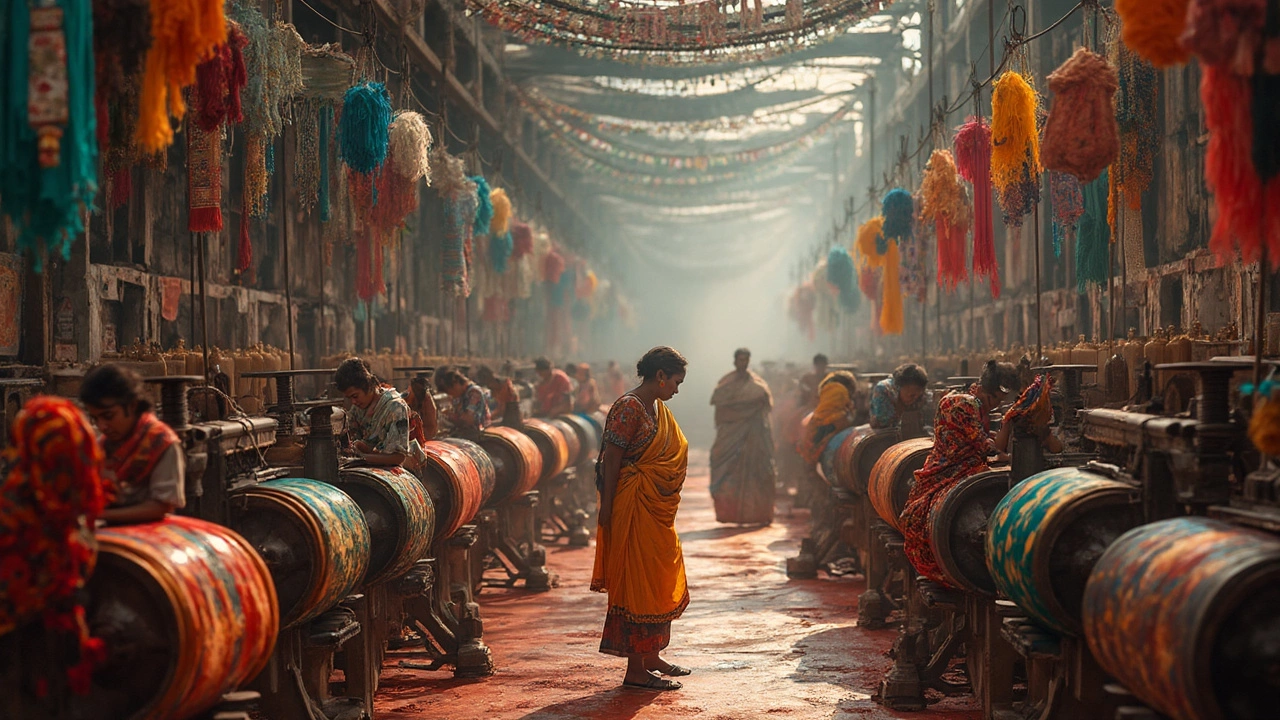- What is the biggest plastic producer company in the world? Oct 28, 2025
- Food Industry Units Explained: Types, Functions & Key Metrics Oct 8, 2025
- Exploring India's Textile Hub: Unveiling the World Capital Mar 26, 2025
- AI Chip Manufacturing in India: Who Makes Them and What's Next? Jul 28, 2025
- India's Biggest Machine: Discover the Largest Heavy Machinery Ever Built in India Jul 16, 2025
February 2025 Archive – Rise Corp India Manufacturing Insights
Welcome to the February 2025 roundup on Rise Corp India. In just a few weeks we covered everything from who’s topping the pharma game in India to the latest buzz on plastic pollution. Below you’ll find quick bites of each story, so you can grab the info you need without scrolling through every single post.
Top Industry Spotlights
First up, we answered the burning question: who is India’s No. 1 pharma company? The post broke down the key factors – R&D spend, market reach, and product pipeline – that set the leader apart from the rest. If you’re watching the pharma market, those metrics are the ones to track.
Next, we dug into the sheer size of the Indian textile sector. The article counted the thousands of manufacturers spread across key hubs like Gujarat, Tamil Nadu, and West Bengal. It also highlighted how regional specialities—cotton in the south, silk in the east—still drive growth.
Small‑scale manufacturers got their moment too. A look at the 2024 boom showed why niche products, eco‑friendly packaging, and 3‑D printing are creating new opportunities for entrepreneurs. The take‑away? Agility and a focus on quality can beat big‑brand inertia.
For metal lovers, we examined the world’s top steel producers and what makes their output stand out. From advanced furnace tech to rigorous quality checks, the post gave practical tips on picking the right steel supplier for your project.
Sustainability & Materials
Plastic pollution is still a hot topic. Our investigation named the biggest corporate polluters and explored how consumer choices and innovative recycling can shift the tide. Knowing the major offenders helps you make smarter sourcing decisions.
Speaking of materials, we listed three alternative names for food processing units (CPU) to clear up the jargon in kitchen‑tech talk. Whether you’re a chef or a home cook, recognizing these terms can make buying decisions easier.
The archive also featured a deep‑dive into the pricey woods used in high‑end Indian furniture. We compared teak, rosewood, and a few rare natives, explaining why scarcity and durability push prices up.
Finally, we rounded off with a global perspective on manufacturing giants and the role of government schemes. The piece showed how policy support can keep large players innovative, while also giving smaller firms a chance to grow.
Got questions about any of these topics? Reach out through our Contact page, or explore the full articles for more details. Stay tuned for next month’s insights—big ideas, real data, and practical tips to keep your business ahead of the curve.
India's No 1 Pharma Company Revealed
- Aarav Sekhar
- Feb 26, 2025
In the bustling world of India's pharmaceutical industry, determining the leading company isn't just about sales figures. From innovation to market impact, several factors set the top firms apart. Discover who holds the crown in this competitive field, learn intriguing facts about India's pharma growth, and explore what makes the top company a leader. Whether you're invested in the industry or just curious, dive into the dynamics shaping the pharma landscape.
How Many Textile Manufacturing Companies Are There in India?
- Aarav Sekhar
- Feb 25, 2025
India's textile manufacturing scene is massive, with thousands of companies scattered across the country. This article dives into the details, examining how these companies contribute to the economy, which regions are the most textile-centric, and what this means for both local and global markets. With a rich history and bright future, India's textile industry is a cornerstone of its economic landscape, providing invaluable employment opportunities and leading innovation. Whether you're a textile enthusiast or just curious, this piece offers an insightful look into a vital sector.
Top 3 Alternative Names for Food Processing Units (CPUs)
- Aarav Sekhar
- Feb 24, 2025
When it comes to food processing units, also known as CPUs, there’s more to know than just the name. In the food industry, these units are often referred to by various terms. Understanding these alternative names can help you navigate the kitchen appliance market more efficiently. This article explores three other common names for these essential food processing tools.
Top Steel Producers: Finding the Best Quality Worldwide
- Aarav Sekhar
- Feb 19, 2025
Discover what makes steel from some manufacturing plants stand out in terms of quality. Learn about the industry's giants and the factors that contribute to their success. Explore the uniqueness of steel production across various countries. Gain insights into advancements that enhance steel quality today. Get practical tips on choosing the best steel manufacturers for specific needs.
Booming Small-Scale Manufacturing Businesses in 2024
- Aarav Sekhar
- Feb 17, 2025
Small-scale manufacturing is set to see significant growth in 2024, driven by demand for niche products, shifts in consumer preferences, and technological advancements. From eco-friendly packaging to custom 3D-printed goods, these industries offer entrepreneurs promising opportunities to explore. With lower barriers to entry and the ability to cater to specialized markets, small manufacturers can thrive by focusing on quality and agility. Entrepreneurs should stay informed about emerging trends to capture these opportunities effectively.
Which Company Leads in Plastic Pollution Today?
- Aarav Sekhar
- Feb 16, 2025
The race to uncover the top plastic polluters brings attention to the adverse impact these companies have on the environment. Learn which corporations are the major contributors to plastic waste, how consumer choices play a role, and discover innovative solutions aiming to tackle this growing concern. From multinational giants to grassroots initiatives, the fight against plastic pollution opens up dialogues on sustainability and corporate responsibility.
Textile Industry Outlook in India for 2024: Key Trends and Insights
- Aarav Sekhar
- Feb 12, 2025
The textile industry in India is gearing up for significant changes in 2024, driven by technological advances and sustainable practices. With both challenges and opportunities on the horizon, manufacturers are investing in innovation to boost productivity. While global demand fluctuations pose uncertainty, India's strong domestic market offers a buffer. Government initiatives continue to play a vital role in supporting industry growth.
Does Sri Lanka Produce Cars? A Look into Automobile Manufacturing
- Aarav Sekhar
- Feb 10, 2025
Sri Lanka, often known for its spices and tea, doesn't typically come to mind when thinking about car production. However, local entrepreneurs and companies have made notable attempts to establish a presence in the automobile industry. Exploring the country's efforts and challenges, this article delves into Sri Lanka's unique role in car manufacturing. From local assembly plants to government initiatives, find out what makes Sri Lanka's automobile scene interesting.
The World's Largest Furniture Manufacturer: An Inside Look at India
- Aarav Sekhar
- Feb 9, 2025
India's furniture industry is booming, with the country becoming a key player on the global stage. In this article, we'll explore who holds the title of the world's largest furniture manufacturer, focusing on India's role in this industry. We'll dive into the factors that contribute to their success, explore the challenges they face, and consider what the future holds for Indian furniture makers. This piece offers a closer look at the key players and trends shaping the market.
Who's Really Behind Plastic Pollution?
- Aarav Sekhar
- Feb 5, 2025
Plastic pollution is a growing environmental issue, with plastic manufacturing companies at the center of the debate. This article explores the role these companies play in pollution and whether we can hold them accountable. With insights into the industry's practices, it's time to understand who shoulders the responsibility for our planet's plastic woes.
Discovering the Priciest Wood for Indian Furniture
- Aarav Sekhar
- Feb 3, 2025
India, a land rich in diverse types of timber, offers a selection of luxurious woods for furniture making. Understanding which woods are the most expensive involves exploring their rarity, durability, and unique characteristics. This article delves into the world of top-tier Indian woods, unveiling their distinct traits and explaining what makes them stand out in the furniture industry. Readers will gain insights into the factors contributing to wood's value and learn how to select the perfect high-end wood for their furniture projects.
Global Giants in Manufacturing: Leaders Shaping the Future
- Aarav Sekhar
- Feb 2, 2025
In the fast-evolving world of manufacturing, a few giants stand out, not only due to their sheer scale but also their ability to innovate and adapt. These companies are often influenced by government policies and schemes, which play a crucial role in shaping the landscape. This article explores the major players in the manufacturing sector, examining how they maintain their dominance and the impact of government interventions. From pioneering new technologies to adopting sustainable practices, these leaders are at the forefront of global manufacturing.











